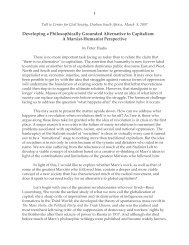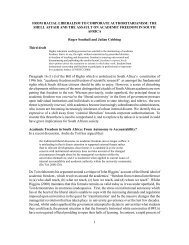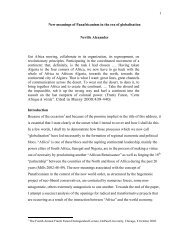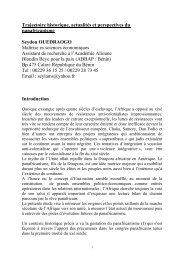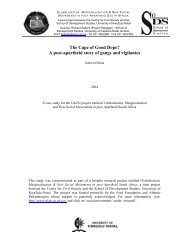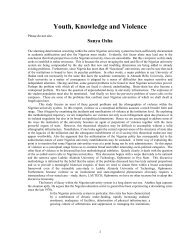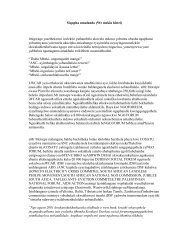April 2011 - Centre for Civil Society - University of KwaZulu-Natal
April 2011 - Centre for Civil Society - University of KwaZulu-Natal
April 2011 - Centre for Civil Society - University of KwaZulu-Natal
Create successful ePaper yourself
Turn your PDF publications into a flip-book with our unique Google optimized e-Paper software.
undertaken with little or no training. The death in 1998 <strong>of</strong> 24-year old<br />
Simon Jones in a shipyard only hours after starting work (with several<br />
minutes “training”) was the first well publicised example to bring this to<br />
peoples’ attention. The trend continued <strong>of</strong> course, with current rates <strong>of</strong><br />
more than 1000 workers killed at work each year (with over 2 million being<br />
killed worldwide). The recent case <strong>of</strong> the Chinese cockle-pickers<br />
illustrated how use <strong>of</strong> illegal migrant labour, leaves such workers in a<br />
hyper-exploited position existing outside any regulatory framework at all.<br />
Little is known <strong>of</strong> the true extent <strong>of</strong> this but sectors known to be heavily<br />
reliant are garment manufacture, restaurants (and associated food<br />
industries like the meat-packing plants in Norfolk), construction and sexwork.<br />
Contract<br />
This amounts to a ratcheting up <strong>of</strong> the discipline applied to labour,<br />
something that applies equally to those in longer-term work. There has<br />
been a long-term change in hiring strategies, with the widespread<br />
introduction <strong>of</strong> fixed contracts in place <strong>of</strong> the “job <strong>for</strong> life”, reducing job<br />
security and <strong>for</strong>cing workers into having to periodically renegotiate their<br />
positions. The teaching pr<strong>of</strong>ession experienced this in the mid-80s, and it<br />
later spread throughout the public sector, <strong>of</strong>ten as a prelude to<br />
privatisation. Agencies are integral to the process <strong>of</strong> privatisation and are<br />
being extensively used in the NHS, especially in care-roles, administration<br />
and support positions. Self-employed subcontracting has long been used as<br />
a way <strong>of</strong> undermining workers organising abilities (<strong>for</strong> example in<br />
construction), and this has now spread to many other sectors. This<br />
uncertainty has lead to the longest working hours and highest levels <strong>of</strong><br />
work-related stress in Europe as workers compete with each other to<br />
retain their jobs. The benefits <strong>of</strong> this to the bosses are obvious: higher<br />
intensity <strong>of</strong> work at lower costs, with the added gift <strong>of</strong> regular unpaid<br />
overtime (according to the TUC, to the tune <strong>of</strong> £23bn last year alone) and<br />
a disincentive to “be difficult”.<br />
According to the National Bureau <strong>of</strong> Statistics, the productivity per worker<br />
has more than doubled in the last 30 years. There has also been a massive<br />
rise in the number <strong>of</strong> workers as women (by choice or necessity) rejected<br />
their traditional roles and entered the job market, and the heightened<br />
disciplining <strong>of</strong> the unemployed marshalled many into low-wage service<br />
sector jobs.<br />
Deregulation <strong>of</strong> labour markets (e.g. through weakening legislation that<br />
once protected job security) makes it easier <strong>for</strong> employers to eliminate<br />
jobs or replace workers with others on less secure contracts. It becomes<br />
easier to pit workers against each other, extracting more labour at times<br />
and places more convenient to the process <strong>of</strong> production. Casualisation<br />
and “labour flexibility” have the overall effect <strong>of</strong> making it more difficult<br />
<strong>for</strong> workers to improve or extend their conditions.<br />
Casualisation As Process: There To Here<br />
The phenomenon being described must be understood as a product <strong>of</strong> the<br />
class struggle. It is very difficult to disentangle the complex<br />
interdependencies <strong>of</strong> cause-and-effect, as every economic development is<br />
a result <strong>of</strong> the manoeuvrings <strong>of</strong> both sides. It seems that the process <strong>of</strong><br />
casualisation is largely a result <strong>of</strong> three factors:<br />
・ the shift from a manufacturing to a service based economy<br />
・ decomposition <strong>of</strong> the working class as a political actor<br />
・ increase in investment capital flows<br />
The shift away from manufacturing (with its traditional high levels <strong>of</strong><br />
unionisation and strong collective bargaining) and towards services (small



